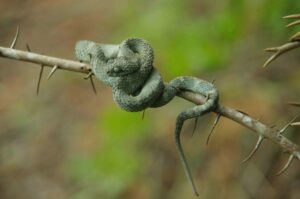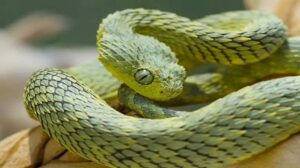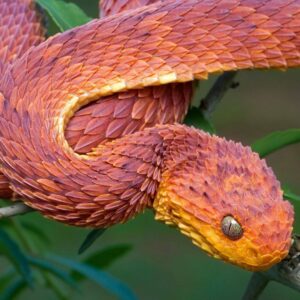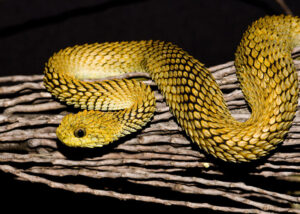African bush vipers, also known as green bush vipers, variable bush vipers, leaf vipers, and Hallowell’s green tree vipers, are found exclusively in Africa. Like all other vipers, they are venomous. They are called bush vipers because they live in bushes.
They are terrestrial, arboreal, and solitary creatures. Owing to their exceptional camouflage, they can easily blend into their environment. Often found 6 meters above the ground, they descend on land to hunt and search for prey. With a reputation for being ill-tempered, they strike if threatened.
Scientific Classifications
- Suborder:Serpentes
- Family:Viperidae
- Genus:Atheris
- Species:A. squamigera
Conservation Status
Description
Size
With an average body length of 18-24 inches (46–60 cm), African bush vipers can sometimes grow more than 31 inches (78 cm). Females are larger than males.
Color and Appearance
These snakes can be of different colors. Their dorsal color varies from light green to dark green, blue, olive, or dark olive-brown. Red, yellow, or slate grey dorsal color occurs rarely. They have broad, flat heads covered with light-colored, keeled, and imbricate scales, sometimes with 30 or more chevrons. Their tails also have 10-19 undefined chevrons and a conspicuous ivory-white tip. When their skin is stretched, an interstitial black color is visible. They have yellow throats, and the color of their bellies is yellow or dull to pale olive.
Neonates are a dark olive color. They have wavy bars and fine dark olive margins at 5 mm intervals. Their belly is pale green olive. After 3-4 months, they develop the adult color pattern.
Their head is covered with keeled and imbricate scales. They have dorsal scales which are invisible from above. Two scales separate the eye from the nasal. They have 7-9 interorbital scales, 10-18 circumorbital scales, 9-12 supralabials, and 9-12 sublabials. Two rows of scales separate the eyes from the labials. Their gular scales are keeled.
These vipers have 15-23 rows of dorsal scales in the midbody, of which 11-17 are present at the back. Their body is covered with 152-175 ventral scales and 45-67 undivided subcaudals.
Are They Dangerous to Humans
An African bush viper bite causes severe inflammation, fever, impaired breathing, and in rare cases, life-threatening hemorrhages. Severe hematological complications in humans have been reported only once. The occurrence of death is infrequent, reported only on two occasions.
It has no anti-venom, but the anti-venom of the genus Echis is partially effective in neutralizing its venom.
African Bush Viper at a Glance
Distribution
African bush vipers live in western and central Africa, ranging from Bioko Island, Democratic Republic of Congo, Ivory Coast, Ghana, Gabon, northern Angola, southern Nigeria to Cameroon, southern Central African Republic, Uganda, Tanzania, to western Kenya. They are widespread in Takamanda Forest Reserve, Cameroon.
Habitat
They live in rainforests, preferring low and thick flowering bushes. These snakes often dwell at elevations of 100-400 m. In the Guinean Forest in West Africa, they are found at lower altitudes because of the presence of dense vegetation. They prefer arboreal, moist, and terrestrial habitats.
Lifespan
The lifespan of these vipers is 10 to 20 years.
Predators
Some large birds and snakes of the same genus will prey on bush vipers. African bush vipers protect themselves from predators by blending into the environment with the help of their camouflaged scale pattern.
Diet
Small mammals are part of their regular diet, with the occasional small bird or reptile. They sometimes show cannibalistic behavior.
They are ambush predators, blending effortlessly into their environment with the help of their body color. When they spot prey, they strike while hanging upside down from a tree limb and inject hemotoxic venom into it through their two front hollow fangs to render it defenseless.
Reproduction
They reproduce once a year during the wet season. These vipers are seasonally monogamous. Courtship involves facing and gesturing their heads and bodies toward each other. The latter is a signal for mounting.
Viviparous by nature, the females can give live birth to a maximum of 19 snakelets in a single litter. On average, 7-9 snakelets are born in one litter. Their gestation period is two months, during which the mother carries the young ones within herself. The neonates are born independent and abandoned by their mothers after birth. Females become sexually mature at 42 months, while males are ready to breed at 24 months of age.
Care Sheet
Size of Enclosure: A terrarium of medium-to-small size is sufficient for these vipers. A vertically oriented terrarium of 15 to 20-gallon capacity is a good fit for them.
Substrate: Substrates used in their enclosure are soil, cypress mulch, old paper towels, or newspapers. It is better to use a natural substrate as it can retain moisture better.
Humidity: Bush vipers prefer to live in a moist environment. A humidity level of 70% – 80% should be maintained in their enclosure. A water source must be kept, or the room should be misted with water occasionally.
Temperature: Being cold-blooded animals, bush vipers require external heat to warm their bodies. The temperature of their enclosure should be around 80⁰F.
Lighting: They don’t need light in their enclosure because they are nocturnal species. However, a light source like a heat lamp is sometimes kept in their enclosure for heating purposes.
Diet/Feeding: These snakes feed on live prey that is small in size.
Source
researchgate.net, fundabook.com, scontent.fccu25-1.fna.fbcdn.net, inaturalist.org, i.pinimg.com, tumblr.com












